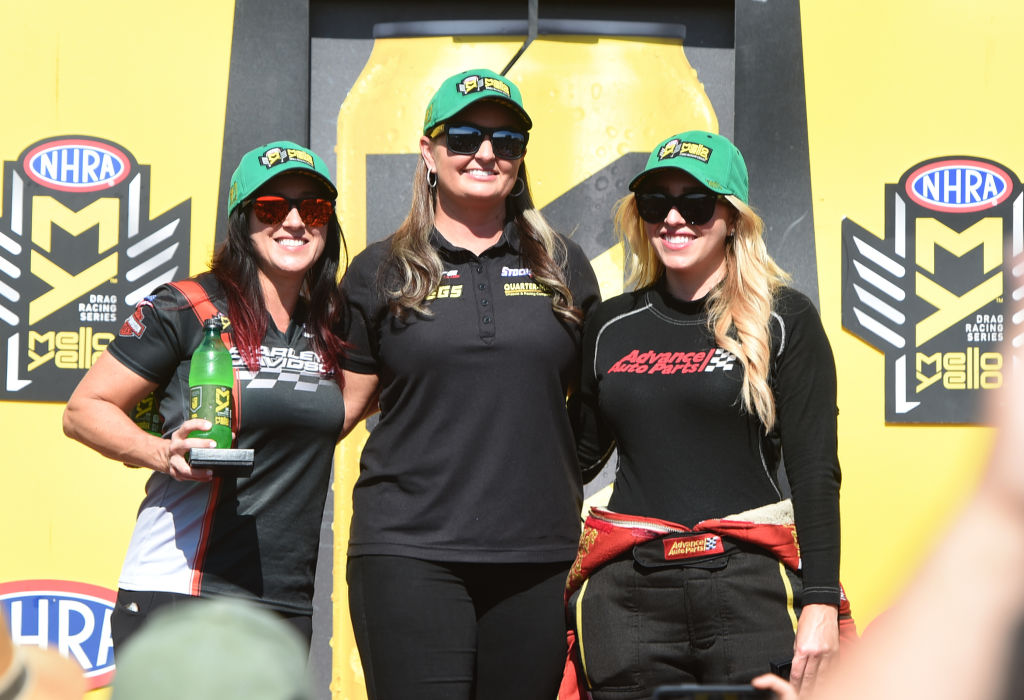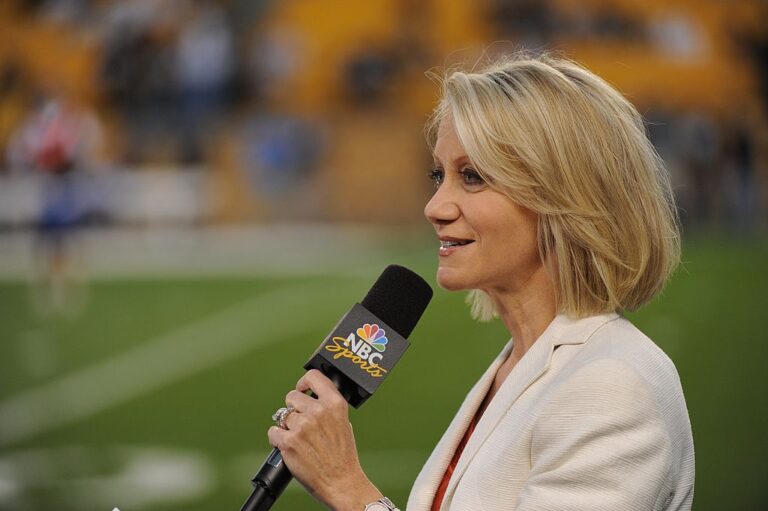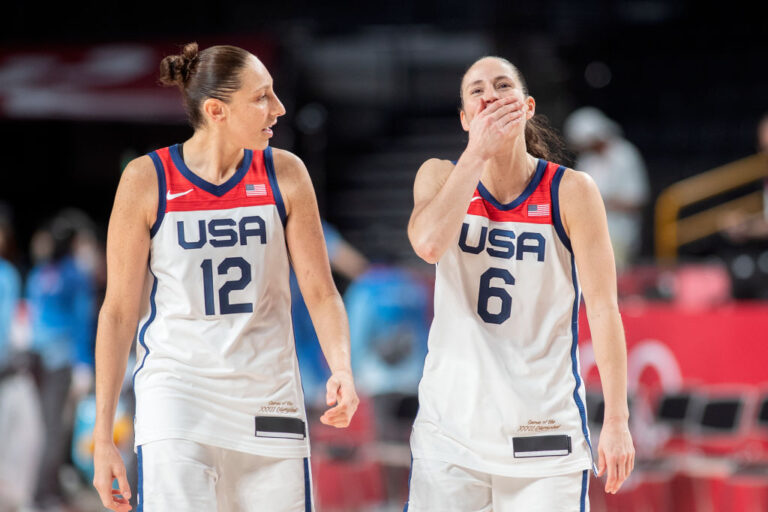Inside the Rise of Women Racers in Professional Drag Racing
Why this matters
Women have been on a steady rise in professional drag racing throughout the 21st century, and this year could see women champions in three of the National Hot Rod Association's top four racing classes.
When drag racer Angelle Sampey debuted in the National Hot Rod Association in 1996, she was not yet a champion, not yet an inspiration. She was an outlier, a woman in a man’s sport just trying to avoid the ire of the men around her long enough to race another day.
“Back then,” said Sampey, “many of the men I raced against were ruthless and did nasty things to try and get me to not come back. This included accusing me of cheating or saying they didn’t want me to crash into them because as a woman I couldn’t handle the motorcycle. Girls today don’t have the rocky road I had.”
The hostility Sampey faced was clearly a tool to get women like her to quit racing, but it instead fueled her success. “I thanked them all for being a**holes to me the past five years,” she remembers saying in her speech after winning her first pro stock motorcycle world championship in 2000. “The way they treated me, such as accusing me of cheating, is what made me so fierce.”
Success for women in drag racing is not a new phenomenon. Sampey’s debut came 14 years after pioneer Shirley “Cha Cha” Muldowney, a three-time champion in the high-speed Top Fuel series who was known as the “First Lady of Drag Racing,” won her final World Championship. But not much had progressed in racing through the 1980s and early ’90s until Sampey arrived.
One of Sampey’s competitors, world record-holding motorbiker Karen Stoffer, debuted nearly a decade later, in 2004. Though Stoffer debuted just eight years after Sampey, she agrees that Sampey “had endured significantly different experiences. … [S]he had to be tough.” Stoffer credits the lack of negativity she received when beginning to compete in the NHRA to the success she had in the Craftsman Series before moving up to the pros.
Related: Women Coaches Face Greater Professional and Personal Obstacles Than Men
This current level of success across classes is a new trend, as there has never been more than one world champion female class winner in the same year.
The NHRA is the world’s largest drag racing sanctioning body, awarding world championships for its top four classes – Pro Stock, Funny Car, Top Fuel, and Pro Stock Motorcycle – each year. Last year, women came in second place in three of these classes. This season, those same three women – Erica Enders, Brittany Force (she has the speed record of 338MPH), and Sampey – are all either in first or second place in their class.
It’s not just incredible women drivers flooding the NHRA. Jobs within the team garages are increasingly filled by women, as are executive positions within the corporate office. Additionally, the number of female fans attending NHRA events has increased 20% in recent years. Sampey shares through firsthand observations that there is also an increasing number of young girls coming out to the track with their families, and she credits the racer’s successes as “why we’ve been able to bring in more girls.”
Sponsors have noticed this too. The opportunity to reach a broader audience of men and women at these events has facilitated these advantageous deals for both racing teams and the NHRA at large. The most prominent example is the current NHRA title sponsor, Camping World, which signed on in 2020. Camping World’s CEO, Marcus Lemonis, cites “the sport’s demographics for the age spectrum of fans, its industry-leading gender and race diversity, and the family appeal” as reasons for this sponsorship.
In a vacuum, this seems like a straightforward business growth formula, and judging by the NHRA’s current tagline (and upcoming video game title) of “Speed For All,” this diversity among racers, teams, and fans is clearly being embraced by the sport today. Now, for the first time in NHRA history, there’s a chance that multiple women will be world champions in the same season.
Some see this growth among women as having happened organically, while others view this as an outcome that resulted from strategic decisions. Looking ahead, the prospect of history being made this season ushers in a potential for overall growth of the sport. That growth may depend on how, or even if, this is something that should be promoted to larger audiences.
From Shirley and Sampey to ‘Speed For All’
One way to account for the growth of women in leadership roles and working in the garages is that they were exposed to the success of other women racing at the track at an impressionable age.
Alexis DeJoria, who has been racing in the Funny Car class since 2005, agreed. “NHRA had a woman [Muldowney] who came in and beat up all the guys and won championships. That's why there are women who can work as executives in the corporate office, jobs on teams, and even crew chiefs today,” she said. “We had a female coming in early in the sport and dominated, and that’s why women are way ahead in this sport as compared to others.”
Force also credits the success of women racers in the pro ranks providing for the opportunity for women in other careers within the race teams or the NHRA. “I’ve seen it growing over the years where we have more and more women working in the industry,” she said. “There are more women now doing the marketing and public relations for race teams as well as with NHRA. However, the change I’ve noticed most is the women who are working on these race cars.”
The NHRA has been making a concerted effort to increase the number of women in leadership. Recently, the organization named a woman a division director for the first time in the sport's history. This is notable as division directors oversee all the tracks within a specific region, including those that host events for lower divisions and hobbyists, which is where the diversity of racing is fostered.
“It’s important that as the sport grows among women that we make sure there are more females on the leadership team and making decisions within our sport,” said Jeffrey Young, vice president of marketing communications for the NHRA. “Having different viewpoints represented inside the sanctioning body and across the sport allows for different perspectives to be voiced and better decisions to be reached.”
As the number of women increases in and around the track, Sampey said she has noticed around the garages that “there are women with clutch dust all over them working their ass off, but the thing is, they don’t look any different to me anymore. Everyone is blending in at the garage, and it’s awesome.”
Organic or Strategic?
Drag racing has achieved a rare degree of parity, resulting not only from the personal and professional disrespect its trailblazers experienced but also from the guidance of the NHRA.
Stressing success in lower divisions before any move up is something that the NHRA credits as one reason the sport has become so inclusive of women. This is because when racers are successful before advancing, their peers in the professional ranks see them as having earned their place.
Young emphasized the importance of the lower divisions. “We have a junior drag racing platform, and boys and girls can start at the age of five,” he said. “Success there leads to a good progression through the divisions to get to the Sportsman ranks.”
All of this reinforces NHRA’s current tagline of “Speed For All” in the sense that, as Young put it, “everyone is equal at the starting line.” Allowing for a grinding meritocracy to usher drivers into the pros is one way that NHRA has helped grow the diversity of this sport.
Another is by embracing its family-oriented product, which can be seen as a natural byproduct of the growing gender diversity in the sport. But drag racing has always been about family.
“Since the sport’s inception, it’s been about spending a weekend with one’s family,” Young says.
Related: The Electric Future of Auto Racing Will Look, Sound and Feel Different
The idea of the sport being family oriented and a way in which it can continue to grow because more and more kids are coming to the tracks is echoed by Brittany Force, the 2017 Top Fuel world champion. Force is the daughter of John Force, who holds the most world championships in NHRA competition, which provides her a unique perspective as someone who grew up around the track and saw full families show up together to watch races.
“When I was a kid and we would go to watch Dad, we were excited when we would see a kid we could play with, … now over the years you see family teams that are out there, and there are grandkids coming and kids everywhere coming out to the races,” said Brittany Force.
Stoffer notes the increase in kids as part of the families coming to the races.
“I pay attention to the kids,” she said. “More familiar are bringing children, … and over the years I've seen more family units coming. I think that is one of the things that the race teams who are comprised of a family made more appealing.”
Stoffer notes that this growth is more organic than strategic, pointing to the fact that as more women started entering the sport, more and more families began bringing their daughters to expose them to the broad range of careers the NHRA had to offer.
“We could now have fans getting exposed to a sport that everyone enjoys and are able to see that their favorite racer’s daughters are now racing,” she said.
‘Just a Racer’
“All of those first female accomplishments are cool, but now that we’ve done it all we don’t think about it,” said Erica Enders, who, in addition to having a Disney movie made about her and her sister’s success as young drivers, is also one of the most accomplished drivers in the sport after winning a fourth Pro Stock world championship in 2020.
“Every record to have, we have accomplished,” she said.
Enders also noted that she honestly doesn’t ever think about being a female on the track before adding, “You can be a racer and not lose your femininity.”
Other drivers also acknowledged this unique duality of who they are as people and competitors.
“The second when the helmet goes on, I call it, ‘The Black and The White,’ and I’m only focused on winning that race,” said Sampey. “I don’t know that I’m a girl. I don’t know if the person next to me is a girl because I only have one job at hand, and that’s to win.”
As soon as the helmet comes off, it is a different story, though. “I’m in Mom mode,” she added. “I’m keeping my makeup fresh.”
“If you come into this sport as just a female racer, you are singling yourself out,” said DeJoria. “When I race, I’m just a racer. That doesn’t affect my femininity in any shape or form.”
This NHRA season has the potential to be in historic territory in terms of female racer success, with multiple women leading the pack. Putting the full identities of these dominant women racers out there can help grow the sport – if the NHRA embraces them.
“We have never had more than two women on the stage for a national event win, ever,” Enders said. “With females competing in all four professional categories, we have a chance to fill the stage, week in and week out. But if we could win the world championship in each of our classes, I would hope NHRA would embrace us and promote us.”
Related: For the NCAA, Building the Business of Women’s Sports Starts With Basketball
That’s where Enders is somewhat doubtful.
“As a four-time world champion, I don’t think they've used me for promotional purposes like they can, especially if it’s to celebrate something so unique and amazing that we fought tooth and nail for,” she said. “We better be [promoted] everywhere. Just to think that many women winning would be incredible, and we could work to continue to grow the sport even bigger.”
Not all drivers agree that a promotional push around the success of female drivers would be the right move.
“I don’t know if I would like to see anything different happen if multiple women win world championships this year,” said Stoffer. “It should always be branded and marketed the same as long as it’s the best people on the stage. I don’t know if I would want to see them handle it differently for the gender that’s up there.”
There is still a lot of pavement between now and the end of the season, so the leaderboards could change, but, as Young puts it, “we don’t have to fluff anything up with our diversity, because people can see that for themselves the first time they come out to the track.”
‘We Have a Good Base’
While there may not be a direct line of decisions that have led to the success of women in the NHRA today, there have been consistent themes and actions, ranging from embracing the family culture to providing opportunities to develop a diversity of talent at young ages.
There have also been pioneering women who had to endure a more hostile and different environment that they were entering into. Sampey’s success led to the success of others, which in turn led to more, and the sport has diversified following that pattern.
Looking ahead, Young said, the NHRA’s “Speed For All” tagline falls on the league and everybody to shoulder together, not just the women. Young added that embracing diversity can help the NHRA stay in a strong position for sponsorships and growth, but “we have a good base since we’ve been growing the sport among women longer than anyone else, and this isn’t some plan we are just now putting into place.”
The racers also voiced that the attitude among many of their male peers has changed significantly over the years. As such, the league’s adoption of “Speed For All” is not just a marketing tagline but something that is practiced by the full NHRA ecosystem already.
“When we hear the scuttlebutt now it’s about being a good driver, not about being a girl,” said Enders. “Now the men say, ‘I don’t want to race her because she’s probably gonna smoke my a**.’”
As this racing season winds down, time will tell if it ends up being historic or not. If it is, it will put the NHRA and the women drivers in a novel position where they have to find a balance between being a female racer versus just a racer. If these women do not all finish atop their classes this year, the inertia seems to suggest it will happen soon enough. As Young puts it, “We don’t just want to bring more females to the track. We want them to win.”
Monthly Issue
Access & Opportunity in Sport
The physical and social benefits of athletic competition are clear, but across the globe, many are still unable to enjoy them.
Can sport evolve to be more inclusive and adapt to the bodies, minds and circumstances of everyone who wants to play?





